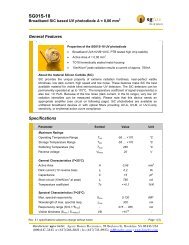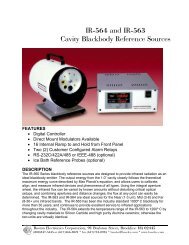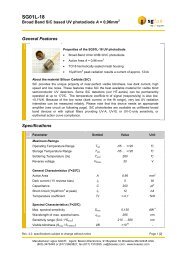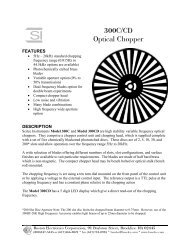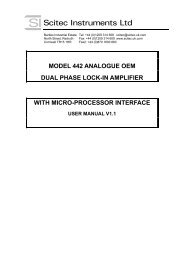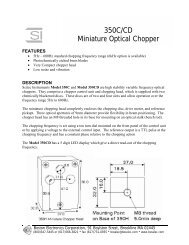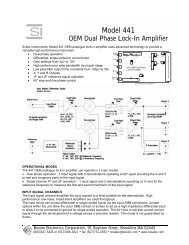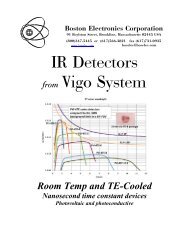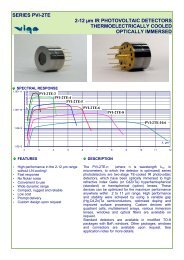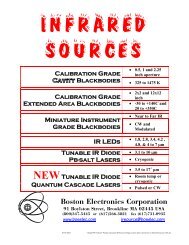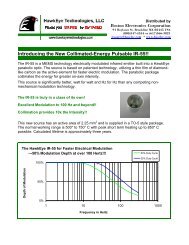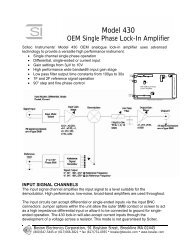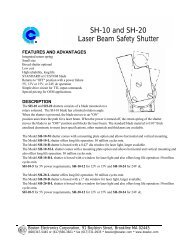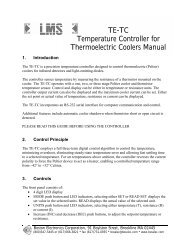Technique F E Reso- Count Multi- Fast Con- RemarkFigure Effi- lution Rate Epon. Scan focalof Merit ciency ps MHz DecayGated Image Intensifier 200ps 4 0.057 20 unlim. yes yes no applicable <strong>for</strong>wide fieldS<strong>in</strong>gle Channel mod. S<strong>in</strong>ewave 3.7 0.07 300 unlim. yes no yes slow scan onlyTechnique Dirac 1.1 0.95 300 unlim. yes no yesModulated Image S<strong>in</strong>ewave 10 0.01 300 unlim. yes yes no applicable <strong>for</strong>Intensifier Dirac 4.3 0.054 300 unlim. yes yes no wide fieldMulti-Gate SPC 2 Gates 1.5-2.1 0.7-0.8 100 30 no no yes8 Gates 1.1-1.5 0.8-0.95 1 because 2 chromophores are detected simultaneously <strong>and</strong> the system is compared with a s<strong>in</strong>glechannel detect<strong>in</strong>g only 1 chromophoreSummaryA wide variety of lifetime imag<strong>in</strong>g techniques <strong>for</strong> time-resolved microscopy is available - gated <strong>and</strong>modulated image <strong>in</strong>tensifiers, s<strong>in</strong>gle channel modulation techniques <strong>and</strong> gated <strong>and</strong> time-correlateds<strong>in</strong>gle photon count<strong>in</strong>g. At the same time two generally different microscopy techniques exist - thewide field microscope <strong>and</strong> the confocal or two-photon laser scann<strong>in</strong>g microscope.For wide field microscopy the gated <strong>and</strong> modulated image <strong>in</strong>tensifiers <strong>and</strong> can be used. Wide-fieldlifetime systems do not have the <strong>in</strong>tr<strong>in</strong>sic depth resolution <strong>and</strong> optical section<strong>in</strong>g capability of theconfocal <strong>and</strong> two-photon scann<strong>in</strong>g systems.For laser scann<strong>in</strong>g microscopes the best results are achieved with multi-gate photon count<strong>in</strong>g <strong>and</strong>with the <strong>TCSPC</strong> imag<strong>in</strong>g technique. Multi-gate photon count<strong>in</strong>g can be used up to very high countrates <strong>and</strong> efficiently detects s<strong>in</strong>gle exponential lifetimes down to a few 100ps. It does, however, notreach the efficiency <strong>and</strong> the time-resolution of <strong>TCSPC</strong>. It is not clear how far the high count rate ofthe technique can be practically exploited because photobleach<strong>in</strong>g sets a limit to the fluorescence<strong>in</strong>tensity obta<strong>in</strong>ed from the excited sample volume.<strong>TCSPC</strong> is able to detect lifetimes down to a few ps <strong>and</strong> is able to resolve the components of multiexponentialdecay functions. It has a near-ideal efficiency <strong>and</strong> is able to detect <strong>in</strong> several wavelength<strong>in</strong>tervals simultaneously. Moreover, the <strong>TCSPC</strong> technique can be used to obta<strong>in</strong> comb<strong>in</strong>ed37
FCS / lifetime data <strong>in</strong> selected spots of a sample. <strong>TCSPC</strong> imag<strong>in</strong>g works at an extremely highscann<strong>in</strong>g speed <strong>and</strong> is there<strong>for</strong>e compatible to almost any laser microscope.Among all methods <strong>TCSPC</strong> imag<strong>in</strong>g with confocal or two-photon microscopes scann<strong>in</strong>gmicroscopes is most suitable to meet the requirements of cell imag<strong>in</strong>g - optical section<strong>in</strong>g, multiwavelengthrecord<strong>in</strong>g, high detection efficiency, high time resolution, resolution of multiexponentialdecay functions, <strong>and</strong> applicability of FCS techniques.References[1] M. M<strong>in</strong>sky : Memoir on <strong>in</strong>vent<strong>in</strong>g the confocal microscope. Scann<strong>in</strong>g 10, 128-138 (1988).[2] J.G. White, W.B. Amos, M. Fordham : An evaluation of confocal versus conventional imag<strong>in</strong>g of biologicalstructures by fluorescence light microscopy. J. Cell Biol. 105, 41-48 (1987).[3] W. Denk, J.H. Strickler, W.W. Webb, Two-photon laser scann<strong>in</strong>g fluorescence microscopy. Science 24 (1990) 73-76[4] A. Periasami, M. Elangovan, H. Wallrabe, J.N. Demas, M. Barroso, D.L. Brautigan, R.N. Day, Methods <strong>in</strong> cellularimag<strong>in</strong>g (ed. by A. Periasamy), 295-308, Ox<strong>for</strong>d University Press, New York[5] B. Herman, Fluorescence Microscopy, 2nd. edn. Spr<strong>in</strong>ger-Verlag, New York 1998[6] J.R. Lakowicz, Pr<strong>in</strong>ciples of Fluorescence Spectroscopy, 2nd. Ed., Plenum Press, New York 1999[7] A. Periasami, R.N. Day, Visualiz<strong>in</strong>g prote<strong>in</strong> <strong>in</strong>teractions <strong>in</strong> liv<strong>in</strong>g cells us<strong>in</strong>g digitized BFG imag<strong>in</strong>g <strong>and</strong> <strong>FRET</strong>microscopy, <strong>in</strong>: Green Fluorescent Prote<strong>in</strong>s, ed. by K.F. Sullivan, S.A Key, Academic Press, 1999[8] M. Elangovan, R.N. Day, A. Periasami, Nanosecond fluorescence resonance energy transfer-fluorescence lifetimeimag<strong>in</strong>g microscopy to localize the prote<strong>in</strong> <strong>in</strong>teractions <strong>in</strong> a s<strong>in</strong>gle cell. J. Microsc. 205 (2002) 3-14[9 ] W.R.G. Baeyens, D. de Keukeleire, K. Korkidis, Lum<strong>in</strong>escence techniques <strong>in</strong> chemical <strong>and</strong> biochemical analysis,M. Dekker, New York, 1991[10] M.R. Eft<strong>in</strong>k, Fluorescence quench<strong>in</strong>g: Theory <strong>and</strong> application, <strong>in</strong>: J.R. Lakowicz, Topics <strong>in</strong> fluorescencespectrocopy, Vol. 2 (1991) 53-126[11] M.A.M.J. van Z<strong>and</strong>voort, W. Engels, C.J. de Grauw, H.C. Gerritsen, D.W. Slaaf, Lifetime imag<strong>in</strong>g of the vitalDNA/RNA probe SYTO13 <strong>in</strong> helthy <strong>and</strong> apoptitic cells. Proc. SPIE 4626-83 (2002)[11a] Van Z<strong>and</strong>voort, M.A.M.J., de Grauw, C.J., Gerritsen, H.C., Broers, J.L.V., Egbr<strong>in</strong>k, M.G.A. Ramaekers, F.C.S.,Slaaf, D.W. Discrim<strong>in</strong>ation of DNA <strong>and</strong> RNA <strong>in</strong> cells by a vital fluorescent probe: Lifetime imag<strong>in</strong>g of SYTO13 <strong>in</strong>healthy <strong>and</strong> apoptotic cells. Cytometry 47 (2002) 226-223[11b] Gerritsen, H.C., S<strong>and</strong>ers, R., Draaijer, A., Lev<strong>in</strong>e, Y.K. Fluorescence lifetime imag<strong>in</strong>g of oxygen <strong>in</strong> cells. J.Fluoresc. 7 (1997) 11-16[12] Jens-Peter Knemeyer, Nicole Marmé, Markus Sauer, Probes <strong>for</strong> detection of specific DNA sequences at the s<strong>in</strong>glemolecule level. Anal. Chem. 72 (2000) 3717-3724[13] M. E. Dick<strong>in</strong>son, C.W. Waters, G. Bearman, R. Wolleschensky, S. Tille, S.E. Fraser, Sensitive imag<strong>in</strong>g ofspectrally overlapp<strong>in</strong>g fluorochromes us<strong>in</strong>g the LSM 510 Meta. Proc. SPIE 4620 (2002)[14] Thomson, N,L., Fluorescence Correlation Spectrocopy. Topics <strong>in</strong> Fluorescence Spectroscopy, Vol. 1, ed. by J.R.Lakowicz, 337-378. Plenum Press, New York, 1991[15] K.M. Berl<strong>and</strong>, P.T.C. So, E. Gratton, Two-photon fluorescence correlation spectroscopy: Method <strong>and</strong> applicationto the <strong>in</strong>tracellular environment. Biophys. J. 88 (1995) 694-701[16] P. Schwille, S. Kummer, A.H. Heikal, W.E. Moerner, W.W. Webb, Fluorescence correlation spectroscopy revealsfast optical excitation-driven <strong>in</strong>tramolecular dynamics of yellow fluorescent prote<strong>in</strong>s. PNAS 97 (2000) 151-156[17] Michael Prummer, Christian Hübner, Beate Sick, Bert Hecht, Alois Renn, Urs P. Wild, S<strong>in</strong>gle-MoleculeIdentification by Spectrally <strong>and</strong> Time-Resolved Fluorescence Detection. Anal. Chem. 2000, 72, 433-447[18] J. Schaffer, A. Volkmer, C. Eggel<strong>in</strong>g, V. Subramaniam, C. A. M. Seidel, Identification of s<strong>in</strong>gle molecules <strong>in</strong>aqueous solution by time-resolved anisotropy. Journal of Physical Chemistry A, 103 (1999) 331-33538



